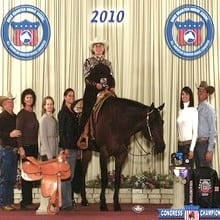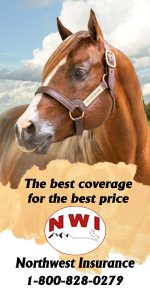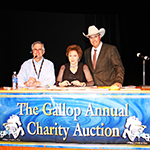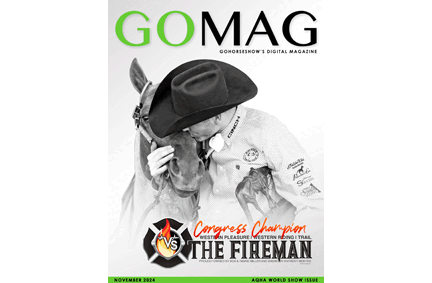Next up in our Congress pattern series is multiple World and Congress Champion and AQHA judge Robin Frid of Denton, Texas. Robin will break down the Congress Youth Horsemanship 15-18 pattern through the eyes of a trainer and a judge. This is also the Amateur Horsemanship pattern as well.
We thought it would be beneficial to our readers to find out from an AQHA Judge whose customers have had success in this class, how the patterns should be executed. Frid’s customers have had great success in Horsemanship and the Congress and World Show level. Courtney Jetelina and Deelivered were the 2010 Amateur Reserve World Champions in the Horsemanship. They also placed in the Top 5 three consecutive years before their Reserve Championship last year. This couple also trained the 2009 and 2010 Congress Novice Amateur Horsemanship Champions. Robin and his wife, Jenny, have over 30 World and Reserve World Championships and 19 Congress Champions and Reserve Champions to their name.
As far as why GoHorseShow chose the 15-18 Youth Horsemanship pattern, we wanted to breakdown the harder patterns because the easier patterns have many of the same maneuvers.
We would also like to thank HorseShowPatterns.com for letting us post the pattern in the article as well as provide a link to the pattern. Please print out the pattern and follow along or click here to open the pattern in a new window.
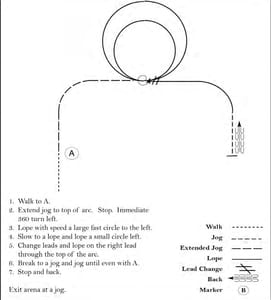 Major Tips From Robin Frid:
Major Tips From Robin Frid:
- When I first look at this pattern with my customers the first thing that we will discuss is that there is only one cone in the pattern that denotes both the beginning and ending. The rest of their drawing is totally up to them to determine.
- I know that more classes than just the 15-18 will be using this pattern. Our first point of discussion will be which arena they will be showing in. If there are in the Celeste, the pattern may very well be quite a bit larger and more forward than it may be in the Coliseum, which is more narrow and tighter.
- I love that this pattern starts at a walk. I encourage all of my riders to always start slightly back off the cone to encourage walking forward motion before executing the next maneuver. With this start–that is taken care of for us. I am looking for a nice forward, ground covering walk that lasts for anywhere between 5-8 steps before stepping into the extended trot. Trot transition needs to occur as the horses nose passes through the cone. It is a wise decision to feel the horse jog a step or even two before pushing up to the extended trot. All to often we see riders that are over anxious and the horse tends to lope off during this cue. Be patient, feel them jog, then use whatever your cue is to step into a forward and powerful extended trot.
- At this point in the pattern, I am looking for an aggressive and strong rider that is not afraid to lay it all out there and rise above their competition. Within that statement, don’t ask for more speed than you and your horse can handle. In the larger arena, I would fully expect this arc to be very forward, and very smooth. Think of a train on a track, rounding a smooth bending corner, very stable, very powerful, and very strong. Stop in the center of your pattern and settle just long enough to know you are stopped before you start your spin. I want to see flow in the pattern, however I am not impressed by an explosion of speed that becomes a blur of things put together.
- Make a mental note know of where you are in the arena, and especially what might be immediately in front of you, as you will need to hit this spot two more times. Step soft into your spin and then increase the speed after you are sure that your partner understands you are turning and not going forward again. This may very well be the most important spot in this pattern to not allow any mistakes, like over or under turning. It is highly likely that the judges may be sitting directly in front of you, so missing this spot is not an option.
- When you step off into the lope from your left spin, I like my riders to feel that horse lope a step or two before asking for any speed, just as we did in the extended trot. Feel them step into gear and get stable, then ask for them to step up. By the third or fourth stride, you should be at full speed. Do not try to go any faster at this point, as your circle may look unbalanced. When creating the circle, try to remember to create space for yourself when you get halfway around so the you have time to prepare for the slow down. One question to ask yourself during the large fast circle is how fast is too fast. Answer #1 is the point that you cannot control it anymore. Answer # 2 is the point that you cannot sit the horse anymore.
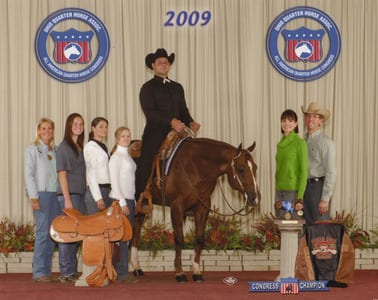
- Prepare for your slow down two to three strides from your center point, so that your can ask for it as your horses nose passes through the mark. Lope straight for a step before entering the small circle. If you have not been able to get your horse as slow as you would like, don’t panic, just keep asking and relax. If you tighten your body, you will find it much harder to get your horse slowed down. Just as in the large circle, create space halfway around the circle to allow yourself ample time for your lead change. Above all else, do not take this lead change for granted!! If we do not do our job, the horse cannot do theirs.
(Pictured here Tom Clopp – 2009 Congress Champion Novice Amateur Horsemanship. Photo © Jeff Kirkbride)
- After the lead change, continue loping on the right lead shaping a beautiful arch to the right. Everything has slowed down now, however, the pattern is far from over. With the slower maneuvers, the judges have ample time to truly access your body position. Be sure to ride strong and still at this point, however do not sit stiff. A stiff rider cannot be effectively connected to their horse, cutting down communication. As soon as you hit your final straight line, lope one more step, and then break to the jog. Be sure that you stop with either your horses shoulder or your leg even with cone A before executing your backup. I foresee many riders stopping early in the pattern, so trust yourself and find the spot that you want to stop and back.
- I would back 4-5 steps, ease your horse back forward, and don’t forget to exit at the jog.
Bio Info–Multiple World and Congress trainer and coach, Robin Frid began training horses in 1991, specializing in all-around events. He became an AQHA judge in 2007. Robin and his wife, Jenny, currently train and teach in Denton, Texas. Robin Frid’s horsemanship video, “Road Map to Success,” is available through GoHorseShow.com.
Stay tuned for the 15-18 Equitation to be analyzed by all-around trainer and AQHA judge Kendra Weis!


